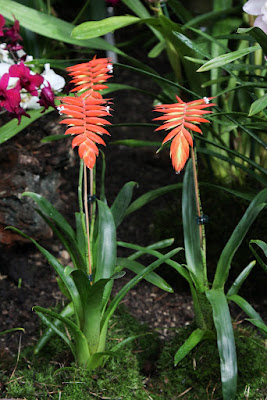Tillandsia dyeriana is endemic to Ecuador. It is known from two subpopulations in Esmeralda and Guayas provinces. It grows in mangrove forest at elevations of 0 to 500 meters above sea level.
Tillandsia dyeriana is a species of the genus Tillandsia. This species was described by Éduard-François André in 1888.
IDENTIFY TILLANDSIA DYERIANA AIR PLANT
Tillandsia dyeriana is endemic to Ecuador. It is known from two subpopulations in Esmeralda and Guayas provinces. It grows in mangrove forest at elevations of 0 to 500 meters above sea level.
It is an acaule epiphyte of medium size (30 to 35 cm) with erect, soft, light green leaves punctuated by small dark spots, especially at the level of the sheath that form a rosette.
This air plant bloom from the single or digitized inflorescence. The ears are flat, 10 to 25 cm long, with orange / bright coriaceous floral bracts, larger than the flowers. The bracts of the flowering stem are imbricate, slightly scaly and spotted with red. The non-fragrant flowers are sessile, small (1 cm wide), non-tubular, white. The flowers bloom from the base of the inflorescence towards its end. The stamens and pistil are included. The flowers last only a few hours, and darken quickly once faded.
TILLANDSIA DYERIANA AIR PLANT CARE AND CULTURE
Cultural information should only be used as a guide, and should be to be adapted to suit you. Your physical location; where you grow your plants, how much time you have to devote to their care, and many other factors, will need to be taken into account. Only then can you decide on the cultural methods that best suit you and your plants.
Light:
Tillandsia dyeriana requires a medium brightness. Like all species with little scales, it can not stand the direct sun in summer. Place the plant very close to a window inside. If you decide to grow it outdoors (not recommended), do it in the shade.
Temperature:
The required temperature ranging from 15 to 32°C. Get it early enough in the fall if you grow it outside, so that it does not face night temperatures below 12 ° C, especially if it is wet.
Humidity:
This air plant need the preferably high level of humidity. Good aeration is required, the plant must dry quickly (in less than an hour).
Substrate, growing media and repotting:
Tillandsia dyeriana can be grow in pot or mounted on a solid substrate that does not retain water. It is often sold in pots but it is possible to deposit it to cultivate epiphyte on a piece of wood for example. You can glue the plant directly to the surface with a strong adhesive, or you can wire the plant to the base. Don't cover the base of the plant with moss or it may rot. It can be grown on almost any imaginable decorative mount, including shells, rocks, slate, driftwood, etc.
Watering:
If the plant is grow as epiphyte, water them every day, summer like winter. The arrangement of the leaves in a tight rosette indicates that it must be watered in the heart, even if it is grown in a pot (do not let water stagnate in the heart at the beginning of flowering, so as not to drown the inflorescence when it does not emerge from the rosette yet). Change the water of the heart once every 2 or 3 days. Although epiphyte, this species is often sold in pot. It is not useless in this case to slightly wet the root ball but do not do it every day, you could rot the base of the plant (just hold the clod slightly wet).
Fertilizer:
This air plant can be fertilized with the moderate doses. 2 to 3 times a month in the summer and 1 to 2 times a month in the winter, depending on the light available and the growth of the plant.

















COMMENTS